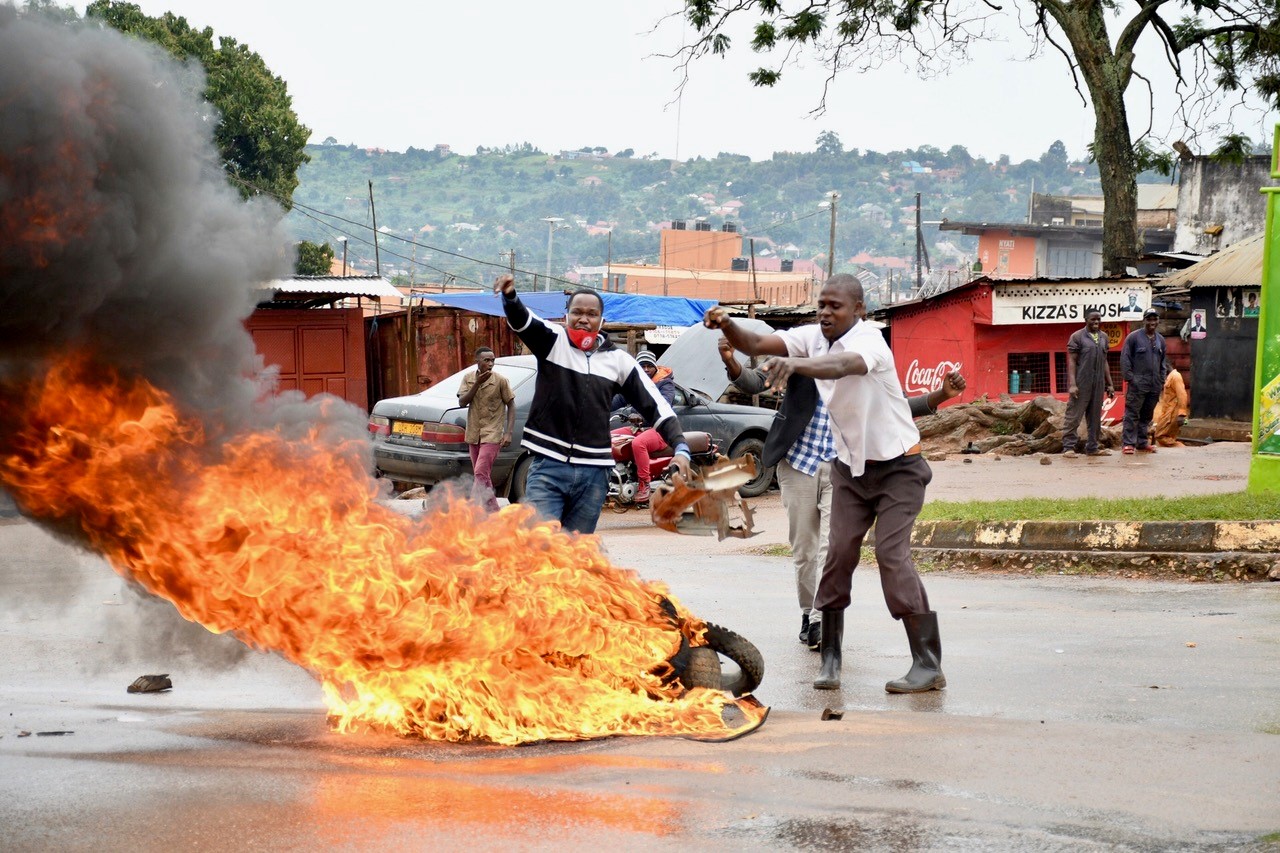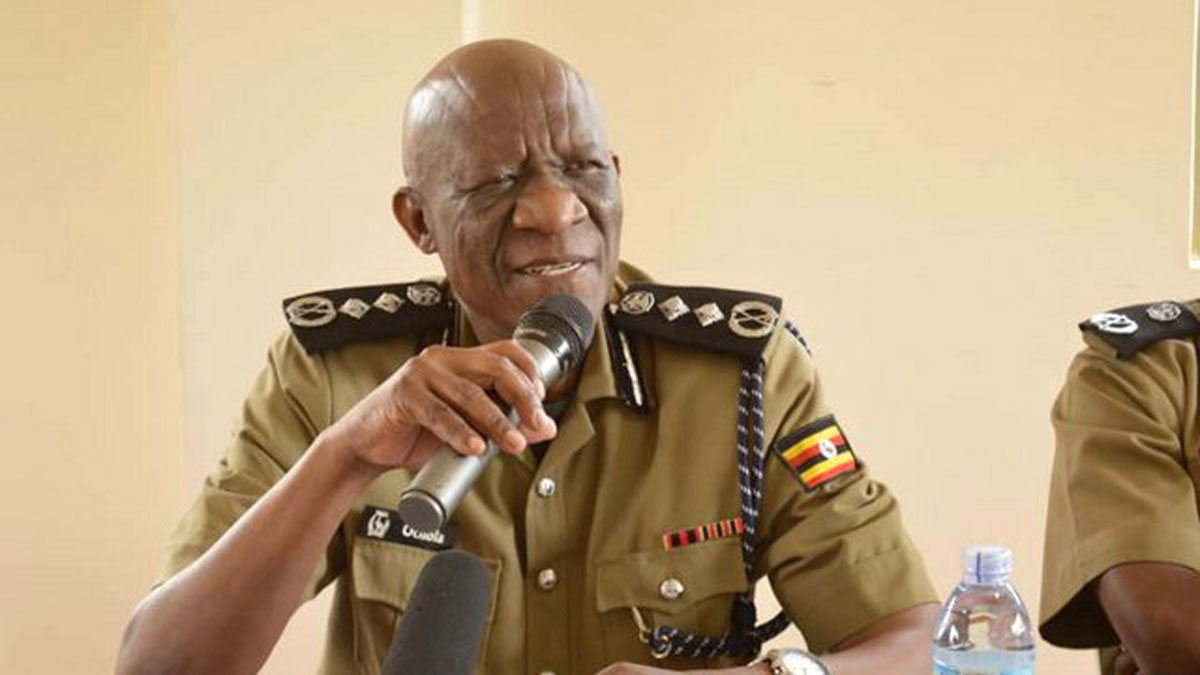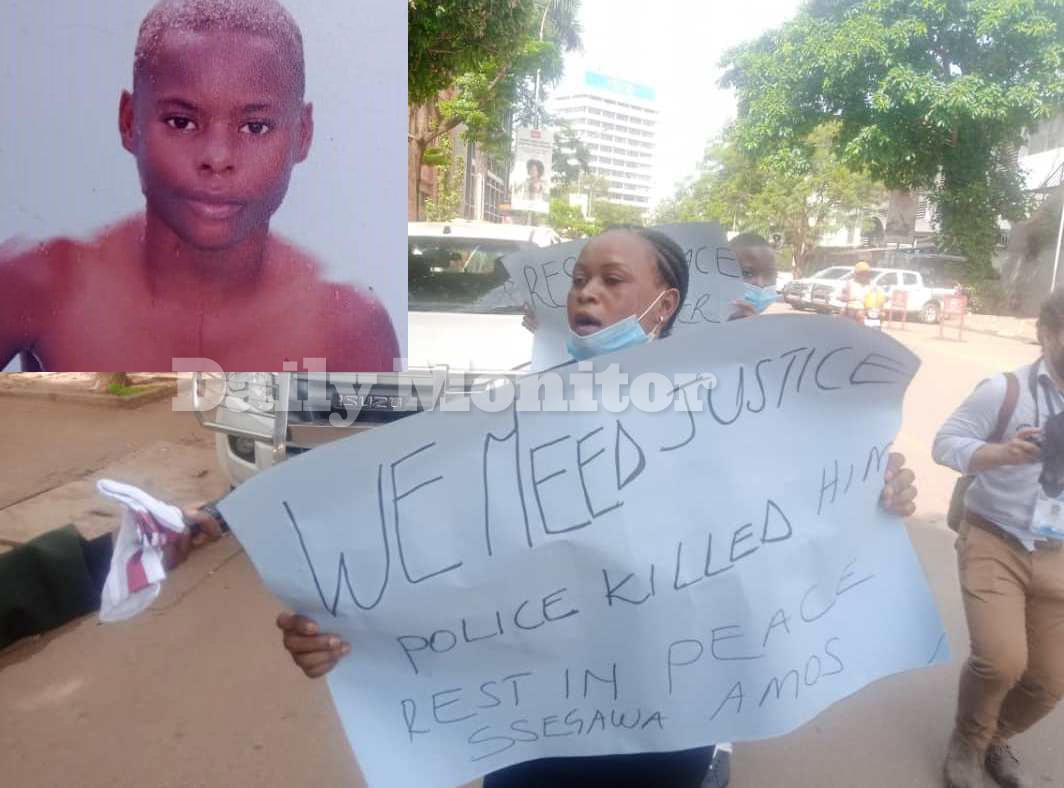Prime
Govt probe report on November riots leaks

Armed men in plainclothes patrol downtown Kampala on November 19, 2020 as protests broke out for the second day following the arrest of Bobi Wine in Luuka District PHOTO/STEPHEN OTAGE
What you need to know:
- 29 people gunned down in Kampala; eight at CPS Kampala, seven in Katwe, six in old Kampala, three in Kawempe, while five were shot in Wandegeya.
- In Wakiso, 13 people were killed, five in Nansana, three in Kira Division, two in Entebbe, one in Wakiso, and two in Nsangi.
- “A stray bullet does not amount to a crime. If I am targeting somebody for a justification, and the bullet hits a person who is not my target, that is not an offence,” CID spokesperson, Mr Charles Twine, CID spokesperson
An investigation by security forces into the November 18-20, 2020 riots has concluded that only 11 of those shot dead were “rioters” while 42 succumbed to “stray bullets”.
The December 5, 2020 findings, whose details we are making public for the first time today, contradict President Museveni’s November 29, 2020 assertion during a televised address that 32 of the fatalities were rioters.
Prepared by Assistant Inspector General of Police Grace Akullo, the director for criminal investigations, for the attention of Chief of Defence Forces, Gen David Muhoozi, the report notes that: “Fifty-four persons died in 49 incidences of death by shooting … of the 54 deaths, 11 victims were rioters, 42 were hit by stray bullets while one was knocked by a motor vehicle reg. no. UAW 827N that lost control after the driver was stoned by rioters along Ben Kiwanuka street in Kampala District.”
Witnesses posthumously identified the woman crushed by the speeding car as 57-year-old Kevina Nalwadda.
In the breakdown provided in the report, 45 were male adults, six female adults and three male juveniles.
This newspaper covered the killings in an incisive series titled; November riots: lives we lost, published over a week from January 4.
Accounts offered by witnesses during our investigations showed that nearly half-a-dozen of those killed in the protests were students, more than 10 were boda boda riders and six were mechanics.
In addition, we found that bullets caught half-a-dozen of the victims in the stomach, a similar number were shot in the neck while about 10 took bullets in the rib cage, chest and back.
At least three of the lethal shots were directly attributed to men in plain-clothes, part of many that fanned out with assault rifles onto city streets and neighbourhoods to quell the two-day madness in the city centre.
Among the dead were two retired civil servants, one house wife and six vendors, including a woman dressed in red-and-black, who as the first fatality symbolised the bloodletting.
Witnesses, who spoke to us identified the security forces by their uniforms and insignia to belong to UPDF, police and Local Defence Unit (LDU), told this newspaper that the security forces fired volleys of bullets indiscriminately, hitting at least a dozen of the victims in the head.
In the police report, which Foreign Affairs minister Sam Kutesa shared with diplomats representing countries that are permanent members of United Nations Security Council during a meeting on April 13, investigators said the actions of security forces were provoked by rampaging rioters who assaulted passers-by, damaged property and blocked and set car tyres alight on roads.
Mr Kutesa “regretted’ the November riot killings, but denied abductions by security forces mainly of the Opposition National Unity Platform (NUP) party, arguing that “anyone suspected of wrongdoing in Uganda will be arrested, invested and subjected to the due process of the law,” according to an April 13 press statement issued by the Department for Public Diplomacy of Foreign Affairs.
The government report cites the incident in central Kampala in which four men, one of them wielding a hammer, were caught on Closed-Circuit Television (CCTV) camera, assaulting ASP Consolata Kasule, the officer in-charge Nakivubo Police station.
Investigators reported that the protestors maliciously damaged one vehicle of a Grade One Magistrate, two State House vehicles, one of Works ministry, one of another government department and two privately-owned cars.
The demonstrators were also accused of forcing women wearing uniforms of the ruling National Resistance Movement (NRM) party to partially undress.
The police report is titled, Report on incidences of death and other cases following the riots that erupted in Kampala Metropolitan area and other parts of the country after the arrest of Hon Kyagulanyi Robert Ssentamu, alias Bobi Wine, on the 18 November 2020.
The shootings happened in the central region, with the exception of the two victims killed in Jinja, which lies in the East.
The highest number of killings, according to the government findings, which corroborate what we reported in the series, happened in Kampala where 29 people were gunned down, eight at CPS Kampala, seven in Katwe, six in old Kampala, three in Kawempe, while five were shot in Wandegeya.
In Wakiso, 13 people were killed, five in Nansana, three in Kira Division, two in Entebbe, one in Wakiso, and two in Nsangi.
Two people were killed in Jinja and three in Mukono, and Seeta, Butambala, Mpigi, Luwero, Wobulenzi, Kikoni-Lwengo and Rakai witnessed one shooting each.
The security report, classified as “highly restricted”, and whose copy this newspaper has seen, names military police personnel, police and soldiers from UPDF’s 1st Division based in Kakiri as those who subdued the disturbances.
It remains unclear if any of them has been charged in the military courts over the shoot-to-kill approach and compensation that President Museveni promised for those innocently killed has not been fulfilled.
Mr Julius Mucunguzi, the spokesperson of the Office of the Prime Minister, which the President tasked to coordinate the pay-out, said: “Any effort in handling that matter is done together with the affected person, not with the (Daily) Monitor newspaper. The matter will be handled or is being handled with the affected person.”
In a televised November 29 address, President Museveni said 32 of those killed were rioters, backed by Opposition politicians, and characterised them “terrorists” in latter addresses some of whom he said had been taken out of action by Special Forces who had distinguished themselves fighting al-Shabaab in Somalia and Allied Democratic Forces (ADF) rebels in the DR Congo.

Protesters burn tyres in Masaka City during the November 2020 riots. Fifty-four people died countrywide. PHOTO/FILE
“Unfortunately, 54 people died in this confusion. Thirty-two were rioters, some were hit by stray bullets and two victims were knocked by vehicles…It is criminal to attack security forces by throwing stones or attempting to disarm them. In that scenario, the police will legitimately fire directly at the attackers if they fail to respond to the firing in the air,” President Museveni said on November 29.
The November 18-19, 2020 riots broke out across different towns in the country following the arrest of then presidential candidate Robert Kyagulanyi Ssentamu, alias Bobi Wine, on November 18 in Luuka District.
Police at the time accused Bobi Wine of flouting guidelines by the Ministry of Health to control the spread of Covid-19 on his campaign trail.
“Joint security forces; UPF and UPDF (Military Police, 1DIV-Kakiri) countered the rioters where 54 deaths were registered,” the report further states.
Asked yesterday if there had been accountability for the many deaths, by police’s own admission from “stray bullets”, the CID spokesperson, Mr Charles Twine, said deaths from stray bullets may attract compensation, but not prosecution.
“We accounted for how many people were shot dead, we identified the people who were killed by stray bullets and the matter was laid on the floor of Parliament by our (Internal Affairs) minister (Gen Jeje Odongo),” he said.
“Not all killings are offences. For a crime to be regarded as a crime you must establish the ingredient and the intention. A stray bullet does not amount to a crime. If I am targeting somebody for a justification, and the bullet hits a person who is not my target, that is not an offence …,” Mr Twine added.
Neither Information Minister Judith Nabakooba, to whom police referred additional inquiries, nor army spokespeople were available for comment.
In the November 29, 2020 addressed, President Museveni tasked police to investigate and explain the numerous killings by stray bullets.
“Police…should audit the phenomenon of shooting people by stray bullets. What was the original purpose of those bullets before they became stray?” he said.

President Museveni
Investigation
Mr Twine yesterday said they have opened a file for each reported case of deaths that happened during the riots and investigations are underway and it does not call for prosecution but perhaps compensation.
“For the record, rioters are not supposed to be shot dead, but there could be a circumstance that during the engagement that somebody could be dead including police officers,” he said.
This newspaper’s series published earlier in the year mentioned a Local Defence Unit (LDU) operative as allegedly having been shot dead by a UPDF commander after he disobeyed an order to shoot a suspected rioter who was known to the LDU man.
The internal government report shows that the post-mortem of the deceased LDU was conducted at Bombo military hospital.
The shootings also claimed the life of Richard Mutyaba, a Local Council I chairperson in Luwero District, who was reportedly gunned by guards of a government official as he tried to rein in youthful protestors on Kampala-Gulu highway.
15-year-old Amos Ssegawa, a senior two student at Lubiri High School (Buloba Campus), was shot while returning home with his mother, who, in seeking justice, has now sued the government.
Postmortem
The report shows that 45 bodies were examined by the Director Police Health Services Dr Moses Byaruhanga at the City Mortuary in Mulago.
Two were examined at Masaka Regional Referral Hospital, one at Gombe Hospital, the autopsy of the LDU was done at Bombo General Military Hospital while post-mortems for two others were conducted at Jinja Regional Referral Hospital.
No autopsy was carried on the body of Gift Nsubuga, the report notes, without giving a reason.
Nsubuga, 16, was a resident of Kyebando and a Senior Two student at St Henry’s College Namugongo in Wakiso District and was the second person to be shot dead at Maison Motel, witnesses told this newspaper for the series.
According to the police accounts in the December 5, 2020 report, 901 suspects were charged, 734 remanded to prison, 167 of them were released on court bail, 113 got out on police bond while police cleared and freed 21 others.
Abridged version of President Museveni’s November 29, 2020 address
“…some of the political actors, working with anti-Ugandan elements from outside, have been promoting impunity and swearing that they will render Uganda ungovernable. We have been monitoring them through intelligence. Working with criminal gangs, whom they pay money and give drugs, taking advantage of serious weaknesses in the police, some areas of Kampala were declared ‘no-go areas’ for law enforcement by these conspirators.
They have been saying that they will burn the petrol stations etc. When, therefore, [National Unity Platform presidential candidate Robert] Kyagulanyi (aka Bobi Wine) and [Forum for Democratic Change flag bearer] Amuriat, were arrested on the 18 November, 2020, those criminal gangs, sponsored by political opportunists and backed by some external elements, decided to execute their long-planned scheme.
They started burning tyres on the roads, mounting illegal roadblocks, robbing Ugandans, beating people, attacking people with [the ruling] National Resistance Movement (NRM) uniforms, stoning cars, stoning security personnel, damaging government cars etc. In spite of the weaknesses of the police that allow such impunity of lawlessness to persist in our towns, the overall security posture of Uganda is robust.
A multi-force response was immediately activated and 1,014 suspects were arrested, of whom 843 suspects were charged in the courts of law including Hon Kyagulanyi. 699 were remanded, 93 released on court bail, while 113 were released on police bond, including Hon Amuriat. 21 were cleared and released and 37 are still in police custody pending [arraignment in] court, including those who burnt Wobulenzi Magistrate’s Court that [and] are facing the charge of terrorism.
Unfortunately, 54 people died in this confusion. 32 victims were rioters, some were hit by stray-bullets and two victims were knocked by vehicles … It is criminal to attack security forces by throwing stones or attempting to disarm them. In that scenario, the police will legitimately fire directly at the attackers if they fail to respond to the firing in the air … We should not have a country of rioters…The idea that Hon. Kyagulanyi, or any politician, is untouchable because he is a politician and if the police legitimately arrest him, there will be riots, is not acceptable and must never be repeated.

IGP Ochola
…You can see the videos of a criminal that was attacking a police woman and a group of criminals undressing NRM women. This will never happen, again. The perpetrators have tested the consequences of playing with fire. It is wrong for some groups to only condemn the security forces, but never condemn law-breakers that attack innocent people, kill them, rob them etc …
“It is criminal to attack Security Forces by throwing stones or attempting to disarm them. In that scenario, the Police will legitimately fire directly at the attackers if they fail to respond to the firing in the air. Many of the up-country Police groups are not equipped with anti-riot equipment (shields, batons, water cannons, rubber bullets etc.) and should not be. We should not have a Country of rioters.”
The original mistake, of course, was by the Presidential candidates that did not adhere to the Ministry of Health guidelines and to imagine that they are immune and can violate those safety measures with impunity. The court system should also help the country by strictly implementing the law so that nobody is led into temptation.
Police … should also audit the phenomenon of shooting people by ‘stray bullets’. What was the original purpose of those bullets before they became ‘stray’? …
I extend condolences to all the Ugandans and their families that lost their lives in these senseless riots. The government will compensate all those who were not rioters, but lost lives in this confusion. The government will also compensate those who lost their properties, if it can be verified.”
Letter to IGP Okoth Ochola dated September 9, 2020
‘‘I am writing to direct you to stop the random shootings by the LDUs and police, all under the command of police,”
“… Shooting to kill should not have been the first option. They should have identified the stone thrower and arrested him for prosecution. The shooting, if at all, should have been to disperse, which would mean shooting in the air. You should analyse incident by incident.”
“Shooting must only be on command and not by individual security personnel letting off guns. Secondly, the standing order of riot control should always be followed to the latter. These include diplomacy- telling people to disperse; proclamation by using hand-held phones to warn them to disperse; inform them of your intention to use forceful means; use of non-lethal means like tear gas; using shields, fire live bullets in the air and only firing to disable if the rioters are charging forward unstoppably and endangering the lives of the security personnel, i.e in self-defense,”
Each police post must have a copy of these procedures and all police personnel and LDUs attached to policing areas, individually, must be conversant to the last letter of these procedures. UPDF units in case they need to support the police must first be educated about these procedures. Nobody should ever be deployed to deal with the public if he/ she is not first sensitized about these procedures,’




